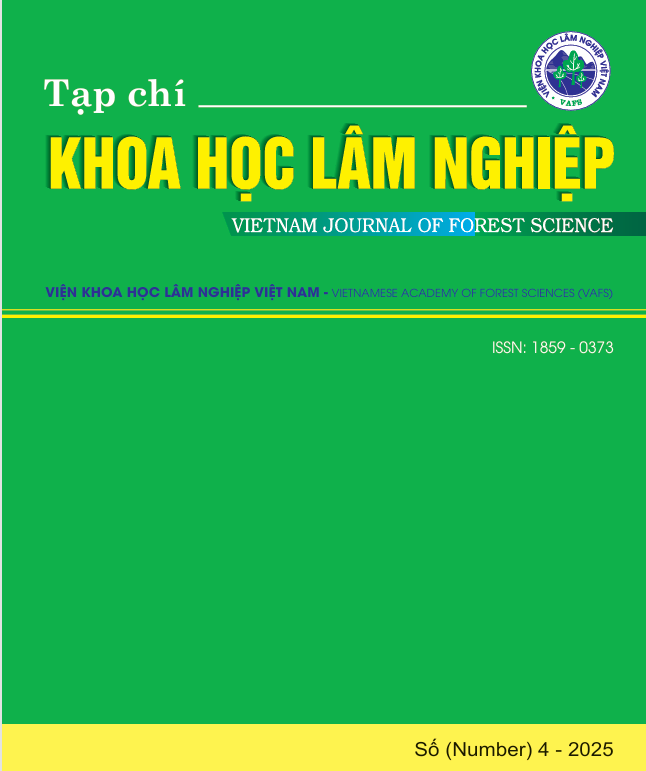DEVELOPING FUNCTIONS TO ESTIMATE DENSITY AND GROWING SPACE INDEXES FOR Rhizophora apiculata Blume PLANTATIONS IN NGOC HIEN COASTAL AREA OF CA MAU PROVINCE
DOI:
https://doi.org/10.70169/VJFS.1063Keywords:
Rhizophora apiculata plantations, stand density index, relative growth spatial index, forest thinning, forest thinning intensityAbstract
SUMMARY
Plantation tending is an important task of silviculture to ensure that desirable individual trees receive adequate space, light, water, and nutrients necessary to thrive. This study aims to develop functions for the rapid estimation of density and growth space indices for Rhizophora apiculata plantations in the Ngoc Hien coastal area of Ca Mau province. Research data were collected in R. apiculata plantations from 10 to 25 years olds; in which each age group was 3 standard plots with an area of 400m2. The density index (SDI) was determined according to the methods of Reineke (1933) and Curtis (1982). The relative growth space index was determined according to the methods of Schröder and Gadow (1999). The research results showed that: (1) The Log(N) - Log(Dg) relationship of R. apiculata plantations from 10 to 25 years olds was a straight line. (2) The SDI of the R. apiculata plantations was determined at class A = 25 years; in which Dg was 20cm and the slope b = 1.538. The SDI index of the R. apiculata plantations from classes A = 10 - 30 years can be predicted by the function SDI = 3177.86×exp (-14.6974×A-1.1441). (3) The relative density index (RD) of the R. apiculata plantations from level A = 10 - 30 years can be predicted by the function RD = 48.9322×exp (-6.36089×A-0.535219). (4) The relative growth space index (RS) of the R. apiculata plantations from level A = 10 - 30 years can be predicted by the function RS = 0.0758799×exp (4.70405×A-0.8861). The findings of this study offer valuable insights that serve as a scientific and practical foundation for establishing technical criteria for tending the R. apiculata plantations in the Ngoc Hien coastal area of Ca Mau province.
References
1. Ban Quản lý rừng phòng hộ Kiến Vàng, 2019. Báo cáo thuyết minh phương án quản lý rừng bền vững đối với rừng phòng hộ, rừng sản xuất tại Ban Quản lý rừng phòng hộ Kiến Vàng giai đoạn 2019 - 2025.
2. Bao, T.Q., Ha, N.T., Nguyet, B.T.M., Hoan, V.M., Viet, L.H., Hung, D.V. 2022. Aboveground biomass and carbon stock of Rhizophora apiculata forest in Ca Mau, Vietnam. Biodiversitas Journal of Biological Diversity 23(1): 403-414 .
3. Curtis, R. O. 1982. A Simple index of stand density for douglas-fir. Forest Science 28(1): 92-94.
4. Lê Văn Cường. 2025. Sinh trưởng của rừng trồng Đước (Rhizophora apiculata Blume) tại khu vực ven biển của huyện Ngọc Hiển thuộc tỉnh Cà Mau. Tạp chí Khoa học và Công nghệ Lâm nghiệp 14(2): 62-71.
5. Nguyễn Thị Hà, Viên Ngọc Nam, Nguyễn Thị Hoa. 2017. Giá trị tích lũy C của rừng Đước tại tỉnh Cà Mau. Tạp chí Khoa học và Công nghệ Lâm nghiệp 6: 101-107.
6. Long, J.N. 1985. A practical approach to density management. Forestry Chronicle 62: 23-27.
7. Philip, G.C, Miriam, W, Gary, K & Sophie, E.H. 2010. Maximum density–size relationships for Sitka spruce and coastal Douglas-fir in Britain and Canada. Forestry 83(5): 461–468.
8. Schröder, J., Gadow, K.V. 1999. Testing a new competition index for Maritime pine in northwestern Spain. Canadian Journal of Forest Research 29 280–283.
9. Nguyễn Văn Thêm, Phạm Minh Toại, 2024. Sinh thái rừng. Nhà xuất bản Khoa học và Kỹ thuật, Hà Nội.
10. Nguyễn Văn Thêm, Lê Hồng Việt. 2024. Xác định chỉ số mật độ và không gian sinh trưởng của rừng trồng keo lai (Acacia hybrid) tại tỉnh Đồng Nai. Tạp chí Khoa học và Công nghệ Lâm nghiệp 13(5): 51-61.
11. Vinh, T.V., Marchand, C., Linh, T.V.K., Vinh, D.D., & Allenbach, M. 2019. Allometric models to estimate above-ground biomass and carbon stocks in Rhizophora apiculata tropical managed mangrove forests (Southern Vietnam). Forest Ecology and Management 434: 131-141.
12. Zeide, B. 1987. Analysis of the 3/2 power law of self-thinning. Forestry Science 33: 517-537.
13. Zeide, B. 2005. How to measure stand density. Trees 19: 1-14.









